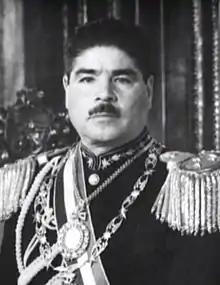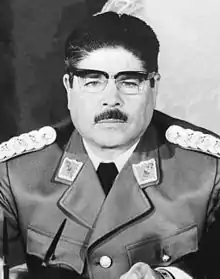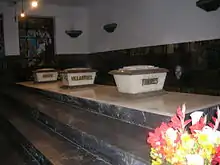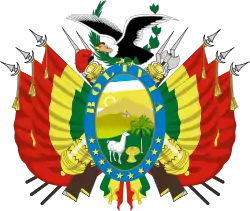Juan José Torres
Juan José Torres González (5 March 1920 – 2 June 1976) was a Bolivian socialist politician and military leader who served as the 50th President of Bolivia from 1970 to 1971, when he was ousted in a US-supported coup that resulted in the dictatorship of Hugo Banzer.[1][2] He was popularly known as "J.J." (Jota-Jota). Juan José Torres was murdered in 1976 in Buenos Aires, in the frame of the United States-backed campaign Operation Condor.[3]
Juan José Torres | |
|---|---|
 | |
| 50th President of Bolivia | |
| In office 7 October 1970 – 21 August 1971 | |
| Preceded by | Alfredo Ovando |
| Succeeded by | Hugo Banzer |
| Personal details | |
| Born | Juan José Torres González 5 March 1920 Cochabamba, Bolivia |
| Died | 2 June 1976 (aged 56) San Andrés de Giles, Buenos Aires, Argentina |
| Nationality | Bolivian |
| Profession | socialist politician, military leader |
| Signature | .svg.png.webp) |
Early life
Torres was born in Cochabamba to a poor Aymara-Mestizo family[4] and joined the army in 1941. He served as military attache to Brazil from 1964 and as ambassador to Uruguay from 1965 to 1966, when he was appointed Labor Minister.
He became the reform-minded Alfredo Ovando's right-hand man and commander-in-chief of the armed forces when the latter came to power as a result of a coup d'état in September 1969. Torres became one of the more left-leaning officers in the Bolivian military, urging Ovando to enact more far-reaching reforms and to stand up to the more conservative officers. As a member of the nationalist and reformist movement of the army, he denounced capitalism because he believed it perpetuates the country's underdevelopment and dependence on foreign countries. In 1969, he had been one of the main protagonists in the nationalization of the Gulf Oil and had participated in the occupation of the company's headquarters in La Paz. On October 6, 1970, an anti-government coup d'état took place, led by right-wing military commanders. Much blood was shed on the streets of various major cities, with military garrisons fighting each other on behalf of one camp or the other. Eventually, President Ovando sought asylum in a foreign embassy, believing all hope was lost. But the leftist military forces re-asserted themselves under the combative leadership of general Torres, and eventually triumphed. Worn out by 13 grueling months in office, Ovando agreed to leave the presidency in the hands of his friend, general Torres, the hero of the moment. The latter was sworn in and went on to govern the country for 10 difficult and tumultuous months.
Presidency

Though most military leaders throughout Latin American history have been associated with right-wing politics, Torres - like his contemporaries Juan Velasco in Peru and Omar Torrijos in Panama - was decidedly left wing. He was known as a man of the people and was popular in some sectors of the Bolivian society. His mestizo and even native-Andean features enhanced his standing with the poorer sectors of society. Despite Torres' best intentions, his marked leftward drift did not stabilize the country. He called an Asamblea del Pueblo, or People's Assembly, in which representatives of specific "proletarian" sectors of society were represented (miners, unionized teachers, students, peasants). The Assembly was imbued with all the powers of a working parliament, even though opponents of the government tended to call it a gathering of "virtual soviets". Torres also allowed the legendary (and Trotskyst-oriented) labor leader, Juan Lechín, to resume his post as head of the Central Obrera Boliviana/Bolivian Workers' Union (COB) and to operate without a single restraint. To his surprise, Lechín proceeded to cripple the government with strikes.
In his first speech as Head of State, he specified the direction of his government: "We will promote the alliance of the armed forces with the people and build nationality on four pillars: workers, academics, peasants and the military. We will not separate the people from their armed arm and impose a nationalist-revolutionary government that will not surrender, will defend natural resources, if necessary at the cost of its own life." It establishes a People's Assembly, similar to a soviet, which meets in Parliament; expropriates the sugar industry; begins negotiations with the Chilean government of Salvador Allende in order to obtain Bolivian access to the sea; amnesty for former rebels who were not murdered after their capture (including Régis Debray); increase the university budget and call for the closure of the United States Strategic Communications Centre (known as Guantanamito)
His government was quickly subjected to external pressure. US Ambassador Ernest Siracusa (who participated in the coup d'état against Jacobo Arbenz in Guatemala in 1954, then was expelled from Peru in 1968, accused of being a CIA man) ordered him to change his policy, threatening him with financial blockage. The World Bank and the Inter-American Development Bank refuse to grant it the loans necessary to pursue industrial development work. But its government is not stable, because it is supported only by a minority of the army and the country's middle class. The wealthy classes, part of the army, the right wing of the MNR and the Phalangist party plot against him.
After less than a year in power, Torres was overthrown in a bloody coup d'état led by the colonel Hugo Banzer, supported by the Brazilian military regime and the United States. Despite massive resistance — both civilian and military — the conservative forces had learned the lessons of the failed October, 1970 uprising, and applied brutality without compunction. Hugo Banzer became President and ruled the country for the next seven years. As for Torres, he fled the country and settled in Buenos Aires, Argentina remaining there even after the March 1976 coup that brought to power General Jorge Videla.
Exile and murder
In early June 1976 Torres was kidnapped, shot and assassinated, most likely by right-wing death squads associated with the Videla government but also — it has been argued — with the acquiescence of Hugo Banzer. His murder was part of Operation Condor.[5]
Despite the short duration of his government, Torres' memory is still revered by the poorest strata of Bolivian society. He is remembered as the smiling general who dared to break the norm of what a Bolivian military leader was supposed to be like. His body was eventually repatriated to Bolivia (in 1983), where it received a massively-attended state funeral.
See also
- Government of Juan José Torres, 1970-1971
- Operation Condor
References
- North American Congress on Latin America (NACLA) September 25, 2007, "Alliance for Power: U.S. Aid to Bolivia Under Banzer," https://nacla.org/article/alliance-power-us-aid-bolivia-under-banzer Archived March 17, 2018, at the Wayback Machine
- Huffington Post, October 23, 2008 updated on May 25, 2011, "U.S. Intervention in Bolivia," https://www.huffingtonpost.com/stephen-zunes/us-intervention-in-bolivi_b_127528.html Archived January 21, 2017, at the Wayback Machine reposted from Foreign Policy in Focus
- "OPERATION CONDOR ON TRIAL".
- International Academy at Santa Barbara, International Academy at Santa Barbara (1970). Current World Leaders. Almanac of Current World Leaders. p. 6.
Juan Jose Torres was born on March 5, 1921, in Cochabamba in a family more Aymara Indian than mestizo.
- "Informe. 30 años del asesinato del general boliviano Juan José Torres en Buenos Aires a manos del Plan Cóndor". jjtorres.com. 12 June 2006 (in Spanish)
External links
| Wikimedia Commons has media related to Juan José Torres. |
- Bolivian government profile of President Juan José Torres (in Spanish)
- Official Website (in Spanish)
| Political offices | ||
|---|---|---|
| Preceded by Alfredo Ovando |
President of Bolivia 1970–1971 |
Succeeded by Hugo Banzer |

